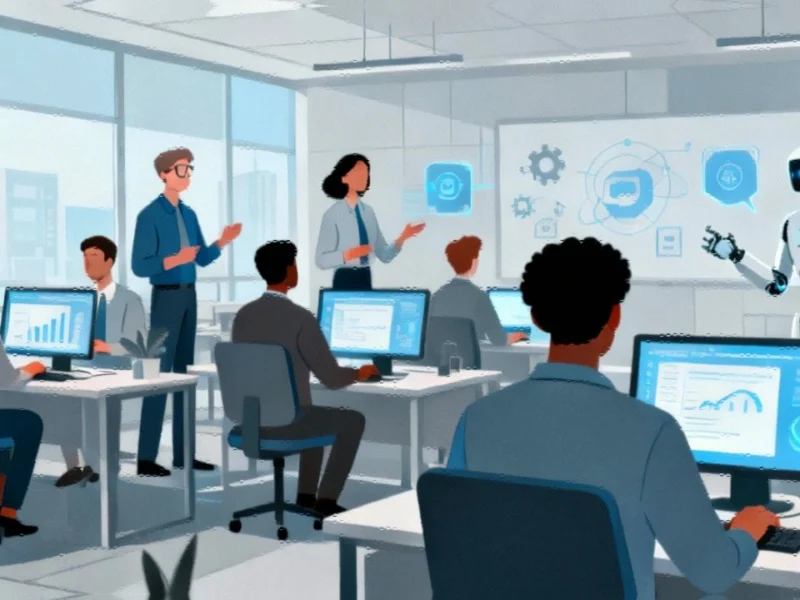Note: Featured image is for illustrative purposes only and does not represent any specific product, service, or entity mentioned in this article.
The Corporate AI Revolution Gets a Practical Makeover
When Citigroup announced it would require AI prompt training for approximately 180,000 employees, the financial giant wasn’t just implementing another corporate training program—it was establishing a new paradigm for how companies can responsibly integrate artificial intelligence into their workforce. Unlike the heavy-handed mandates emerging elsewhere in corporate America, Citi’s approach represents a nuanced understanding that successful technology adoption requires empowerment rather than enforcement.
According to Tim Ryan, the bank’s head of technology and business enablement, the training ranges from just 10 minutes for AI-savvy employees to about 30 minutes for beginners. This modest time investment reflects a deliberate strategy: provide just enough knowledge to boost the average employee’s AI proficiency without bogging down the organization in lengthy, comprehensive training sessions that would consume hundreds of thousands of productive hours.
The Psychology Behind Citi’s “Optional But Equipped” Approach
What makes Citi’s strategy particularly noteworthy is what it doesn’t require. Unlike Moderna’s CEO, who made headlines in April 2024 by demanding employees use AI at least 20 times daily, Citi isn’t mandating usage. Instead, the bank is focusing on capability-building, trusting that well-trained employees will naturally gravitate toward tools that make their work more efficient.
This philosophy aligns with what organizational psychologists have long understood about technology adoption: forced compliance generates resistance, while genuine competence creates enthusiasm. By giving employees the skills to use AI effectively—particularly in prompt engineering—Citi has created conditions for organic, sustainable AI integration.
Demystifying Prompt Engineering: The Core Competency
At the heart of Citi’s training is prompt engineering—the art of crafting questions and instructions that guide AI systems to produce precisely the outputs users need. Think of it as similar to briefing an intern: you start with a general concept, review their initial attempt, then refine your instructions until you get exactly what you envisioned.
This skill has become increasingly crucial as AI systems become more sophisticated. Proper prompt engineering can mean the difference between receiving a generic, barely-useful response and obtaining a tailored, actionable output that saves hours of work. The bank’s system has already been prompted over 6.5 million times during 2024, equating to approximately 36 prompts per employee—evidence that when employees understand how to communicate with AI, they use it voluntarily.
The Broader Implications for Corporate Technology Strategy
Citi’s approach arrives amid significant industry developments in how companies manage technology transitions. The financial sector’s cautious but deliberate embrace of AI contrasts with the tech industry’s sometimes-breakneck adoption pace, offering a middle path that other regulated industries might emulate.
The strategy also reflects a growing recognition that AI’s greatest value lies in handling routine tasks, freeing human workers for more complex, strategic work. This aligns with related innovations in knowledge work, where AI-assisted research and analysis tools are transforming how professionals access and process information.
Beyond Banking: Lessons for Every Industry
While developed for financial services, Citi’s training philosophy contains universal principles applicable across sectors:
- Respect employee time with focused, just-in-time training rather than exhaustive courses
- Build capability rather than mandate usage to foster genuine adoption
- Focus on practical skills like prompt engineering that deliver immediate value
- Trust empowered employees to identify where technology can enhance their work
These principles become particularly relevant considering market trends in generative AI, where tools are becoming increasingly sophisticated yet require thoughtful human guidance to deliver their full potential.
The Future of Work: Human-AI Collaboration
Citi’s initiative points toward a future where AI doesn’t replace workers but instead becomes a collaborative partner. The bank’s measured approach—training without mandating, empowering without overwhelming—suggests a maturation in how corporations view technological change.
As more organizations observe Citi’s results, this balanced strategy may become the new gold standard for technology integration. The ultimate lesson may be that the most successful AI implementations aren’t those with the most aggressive adoption targets, but those that create the most competent and confident users.
This article aggregates information from publicly available sources. All trademarks and copyrights belong to their respective owners.



